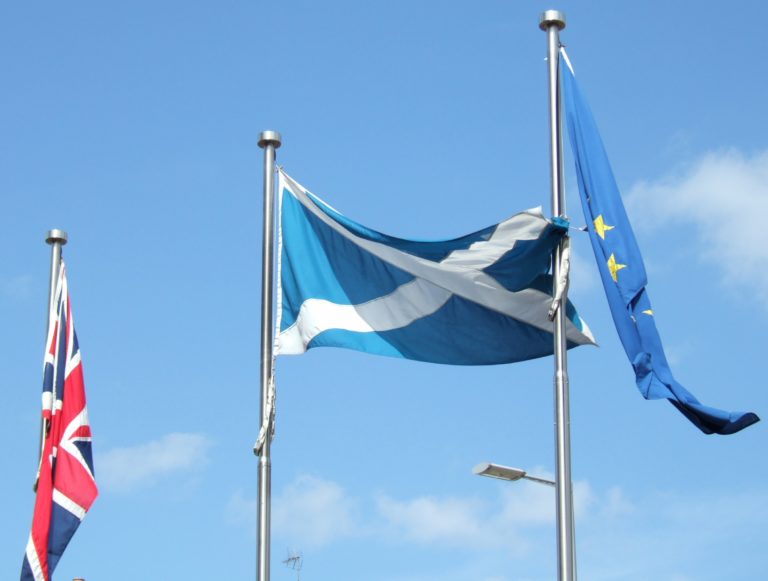Unless you have somehow managed to escape the Brexit madness by relocating to the moon, it won’t have escaped your notice that Westminster and Holyrood don’t exactly see eye-to-eye over Brexit.
Scotland voted overwhelmingly to remain in the EU; England and Wales voted overwhelmingly to leave. The Scottish Parliament voted by a clear majority to withhold legislative consent to the EU Withdrawal Bill, the UK Government passed the Bill anyway. Scotland wants to stay in the Single Market, the UK Government has made clear that the whole of the UK will be pulled out after Brexit.
Most of these disagreements have been played out across the debating chambers of the two Governments and in official statements read out by newsreaders on the 10 o’clock news, but today, the political standoff has become a legal one, with the Supreme Court being called to rule on whether Holyrood’s EU Continuity Bill is legal. The results of this ruling, not expected until the autumn, will have far reaching ramifications for the whole of the UK.
What is the EU Continuity Bill?
The EU Continuity Bill was introduced to the Scottish Parliament after it became clear negotiations about where the powers that would ordinarily be devolved under The Scotland Act should lie after the UK leaves the European Union. Holyrood maintains powers ordinarily devolved should be returned to the Scottish Parliament, whereas the UK Government argues they should be returned to Westminster for an uncertain period in order to create ‘UK-wide frameworks’ and to allow the UK Parliament to maintain final say over how these frameworks should operate.
The UK Government’s position on this has proved extremely controversial in Scotland, with the Scottish Government viewing this as a ‘power grab’ and many MSPs worried the UK Parliament could pass laws on behalf of Scotland to which the Scottish Parliament are fundamentally opposed. As a result, the Scottish Parliament voted overwhelmingly to withhold legislative consent to the EU Withdrawal Bill.
In the aftermath of this vote, the Scottish Government decided to table their own emergency legislation in the form of their own version of the EU Withdrawal Bill named the Continuity Bill. This Bill would transfer all areas ordinarily devolved and currently under the control of the European Union to the Scottish Parliament on exit day.
The Continuity Bill is different from the EU Withdrawal Bill in that it enshrines environmental standards and human rights from the EU into Scots Law and allows the Scottish Parliament to imitate future EU laws and regulations in devolved areas after Brexit.
The Continuity Bill was placed before the Scottish Parliament and passed with a clear majority – only the Scottish Conservatives and a single Liberal Democrat MSP voted against the Bill.
Why is the Supreme Court involved?
There is disagreement about whether the Scottish Parliament has the authority to pass the Continuity Bill. In an unprecedented move, the Presiding Officer of the Scottish Parliament Ken Mackintosh raised concerns that the Bill breaks EU law and refused to give his backing to the legislation, stating it:
“anticipates the impact of the withdrawal of the United Kingdom from the European Union”, and “assumes the parliament can make provision now for the exercise of powers which it is possible the parliament will acquire in the future”.
However, Scotland’s top law officer, the Lord Advocate James Wolffe disagrees. In an address to MSPs in Holyrood, Wolffe stated the said the Continuity Bill:
“does nothing which will alter European Union law, or which undermines the scheme of EU law, while the United Kingdom remains a member of the EU.”
He added the Bill was drafted in the same principle as the UK’s EU Withdrawal Bill meaning if it is found the Bill is contrary to EU law, the same principle would have to apply to the UK’s EU Withdrawal Bill.
This position is backed by the Welsh and Northern Ireland Assemblies who have made submissions to the Supreme Court in support of the Scottish Government’s position.
Despite these interventions, the UK Government’s law officers lodged a legal challenge at the Supreme Court, arguing they needed “absolute clarity” on whether Holyrood is within its rights to pass the Bill.
What are the possible outcomes?
There are three likely outcomes for this case.
The court could:
- Rule the Bill lies entirely under Holyrood’s remit and allow it to become law;
- Rule the Bill is not within Holyrood’s remit and it cannot receive Royal Assent to become law;
- Rule parts of the Bill lie under Holyrood’s remit, while referring parts of the Bill back to the Scottish Parliament to be re-drafted or removed.
It is important to note that if the second option is passed down, the ruling is highly unlikely to be the end of the story for the Continuity Bill. If the court decides to throw out the Bill completely, Scottish Ministers are likely to seek to amend the Bill in accordance with the Judges’ rulings on Holyrood’s competence.
In any case, the judgement of the Supreme Court will have significant political ramifications for the UK.
If the Bill stands, even amended, it is unlikely Scotland and the rest of the UK will be on the same path after Brexit. The Scottish Bill includes several provisions that do not exist in the EU Withdrawal Bill, including the power to allow Scotland to ‘keep pace’ with EU laws after Brexit, including in environmental standards and human rights.
The UK Government would therefore have to decide whether it will also ‘keep pace’ with EU laws after Brexit, or set the rest of the UK on a different course than Scotland – with different rules and regulations and with Scotland having easier access to EU markets.
Alternatively, under current constitutional arrangements, Westminster could step in and block the Continuity Bill anyway – thereby keeping Scotland on the same legal path as the rest of the UK.
This would, however, result in a constitutional headache for all involved, with many viewing such action as a threat against devolution itself. It is also highly likely to reignite calls for Independence in Scotland – something that the UK Parliament wants to avoid.
Whatever the outcome, this standoff is the sign of things to come. With Holyrood and Westminster so fundamentally opposed, and the Scottish Government’s steadfast commitment to withholding legislative consent to those UK Brexit bills it views as not being in Scotland’s interest, it is likely we will see more legal challenges and strong words from both sides in the months ahead.





